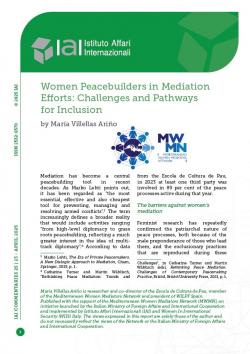Women Peacebuilders in Mediation Efforts: Challenges and Pathways for Inclusion
Mediation has become a central peacebuilding tool in recent decades. As Marko Lehti points out, it has been regarded as “the most essential, effective and also cheapest tool for preventing, managing and resolving armed conflicts”.[1] The term increasingly defines a broader reality that would include activities ranging “from high-level diplomacy to grass roots peacebuilding, reflecting a much greater interest in the idea of multi-track diplomacy”.[2] According to data from the Escola de Cultura de Pau, in 2023 at least one third party was involved in 89 per cent of the peace processes active during that year.
The barriers against women’s mediation
Feminist research has repeatedly confirmed the patriarchal nature of peace processes, both because of the male preponderance of those who lead them, and the exclusionary practices that are reproduced during these processes.[3] Women continue to be underrepresented in peace processes and, as contacts between the warring parties in an armed conflict are formalised, women who have carried out mediation tasks at the local level progressively disappear from the scene, generally giving way to international mediation teams.[4] Indeed, the high-level evaluation of the implementation of the Women, Peace and Security (WPS) agenda by the United Nations in 2015 found that women’s participation in peace processes was one of the areas of peacebuilding in which the most challenges remained.[5] Nine years later, the Secretary General acknowledged in his latest WPS report that there is “a lack of overall progress on women’s full, equal and meaningful participation in peace processes” with data showing that on average, women were 9.6 per cent of negotiators, 13.7 per cent of mediators and 26.6 per cent of agreement signatories.[6]
The observation that mediation has been one of the great gaps in the implementation of the WPS agenda has led in recent years to the emergence of initiatives and formulas to respond to this weakness. Women’s civil society organisations (CSOs), women diplomats, governments and international institutions have explored ways, not without challenges and obstacles, to promote mediation standards in accordance with the requirements established in the different Security Council resolutions, such as consultation processes with women CSOs or gender technical expertise provided to mediation teams.
In peace processes, actors who have carried out mediation tasks have played both positive and negative roles with respect to the inclusion of women and gender agendas. In some cases, such as Syria, Mali or Libya, the role of third parties has contributed to hindering women’s participation, acting as gatekeepers. Third parties have questioned women’s legitimacy or representativity and have expressed reluctance to women’s inclusion due to cultural reasons or have even ignored their right to participation.
Women’s mediation on the ground: Achievements and obstacles
In other cases, the role of the mediating actors has been positive and has served to promote, facilitate and legitimise the participation of women and the negotiation of gender agendas within the framework of the dialogues. Some examples can be found in the processes in Colombia between 2012 and 2016 – with a broad participation of women in different spaces of the negotiations – the National Dialogue process in Yemen between 2013 and 2014 – a quota of 30 per cent of women was established for all delegations included in the dialogue – or the negotiations in Kenya after the electoral crisis of 2007 – each of the parties that participated in the dialogue included a woman in its delegation.
On many occasions, the activism of women’s peace movements organised around the issue of participation in negotiations has been an important path for the inclusion of women and the gender perspective. Mediation teams have been an advocacy target for women’s organisations, to achieve more inclusive processes, asking mediators to pressure conflict parties regarding the inclusion of women and advocating feminist agendas and recognition of women’s rights to be part of the negotiations.
In Colombia, the push of these organisations grouped in the National Summit of Women and Peace (Cumbre Nacional de Mujeres y Paz),[7] achieved the inclusion of several women in the negotiating teams, the establishment of the gender subcommission and an agreement in which the gender approach permeated the entire text in a transversal way, as well as different institutions in charge of implementation and verification of compliance.
In Afghanistan, the inclusion of four women in the government negotiating team in the dialogue process with the Taliban, which was unsuccessfully carried out between 2020 and 2021, was due partly to the work of women’s CSOs. In the previous years, they had led different advocacy efforts to be included in talks with the Taliban.[8] In Sri Lanka, the women’s movement forged alliances with women’s organisations at the international level to strengthen their demands on the parties to the conflict and to be included in the peace process. After the start of the negotiations, Sri Lankan women’s organisations promoted an international mission to the conflict areas to prepare a report with recommendations for the process. This report led to the decision to establish the gender sub-committee for the negotiations as a participation structure for women. Sure, the formula for participation agreed upon at the negotiating table was not proposed by women, who aspired to have 30 per cent representation of women in all the committees of the negotiations, but – as one of the members of the subcommittee pointed out – “we were given an opportunity and we’ve taken it”.[9] However, the peace process failed to be successfully completed.
The (not always) enabling role of the international community
Support from the international community, however, cannot taken for granted. In Syria, for example, women’s organisations initially tried to influence the United Nations special envoy, Lakhdar Brahimi, to gain a space at the negotiating table to no avail. It was not until the appointment of a new special envoy, Staffan de Mistura, that they achieved a greater commitment to their inclusion in the negotiations, in a process fraught with difficulties and contradictions. In Libya, women’s organisations asked the United Nations and various countries involved in the national transition process for assistance in order to be included in the high-level meeting convened in 2011 backing the Benghazi National Transitional Council, but they did not obtain the support of international actors for their demands.
Some of the challenges that persist in achieving a gender-sensitive mediation and facilitation efforts point to the structural difficulties in ensuring that the WPS agenda becomes a transformative tool in a context of predominance of liberal peace marked by neo-colonialism that constantly excludes women from the global South. The international community has favoured the participation of specific groups of women and, often, their instrumentalisation with the aim of promoting a certain international agenda of peace and security.[10] Thus, sometimes the WPS agenda has become a tool for building liberal peace and not so much for addressing the structural causes of conflicts with little impact on gender inequalities related to armed conflict or violence. Aspects such as profound economic transformations that have to do with the inequalities resulting from the neoliberal international economic order have been left off the agenda, and consequently from the discussions in most peace processes, with enormous consequences for women both during and after armed conflicts. Frequently the most critical groups of women or those that have most directly experienced the impact of these neoliberal economic policies are not part of the repertoire of local actors with whom the international bureaucracy of the WPS agenda interacts and, above all, the facilitating actors in peace negotiations.
Challenges and opportunities ahead
Other challenges point to dilemmas intrinsic to mediation practice, insofar as the values and norms promoted by mediating actors can be perceived as political agendas. In a context in which the WPS agenda is increasingly considered as an effective and fair tool for sustainable peacebuilding, despite the aforementioned challenges and limitations, its promotion by mediator or facilitator actors should not be perceived as an attempt at self-interested interference during a peace process, but rather as an adaptation to international standards on human rights and gender justice, provided that it is accompanied by processes in which meaningful participation is promoted to include a wide spectrum of actors representative of local diversity.
Given the non-linear nature of peace processes, with constant advances and setbacks, as well as the multiple phases in which they take place and the increasing diversity of tasks performed by third parties through them, facilitating actors such as mediators or advisors can be essential levers for women’s participation in negotiations. Facilitation and mediation make it possible to convey to the negotiating actors suggestions on unexplored or alternative paths to achieve peace. Women, and other traditionally excluded groups, have developed agendas and proposals that enrich both the negotiations and the resulting peace agreements and also have the potential to overcome entrenched obstacles that frequently hinder settlements. Therefore, the proactive dimension of mediation constitutes an opportunity to promote peace processes that make inclusion and gender justice a distinctive sign.
María Villellas Ariño is researcher and co-director of the Escola de Cultura de Pau, member of the Mediterranean Women Mediators Network and president of WILPF Spain.
Published with the support of the Mediterranean Women Mediators Network (MWMN), an initiative launched by the Italian Ministry of Foreign Affairs and International Cooperation and implemented by Istituto Affari Internazionali (IAI) and Women In International Security (WIIS) Italy. The views expressed in this report are solely those of the author and do not necessarily reflect the views of the Network or the Italian Ministry of Foreign Affairs and International Cooperation.
[1] Marko Lehti, The Era of Private Peacemakers. A New Dialogic Approach to Mediation, Cham, Springer, 2019, p. 1.
[2] Catherine Turner and Martin Wählisch, “Rethinking Peace Mediation: Trends and Challenges”, in Catherine Turner and Martin Wählisch (eds), Rethinking Peace Mediation. Challenges of Contemporary Peacemaking Practice, Bristol, Bristol University Press, 2021, p. 1.
[3] Thania Paffenholz, “Women in Peace Negotiations”, in Karin Aggestam and Ann E. Towns (eds), Gendering Diplomacy and International Negotiation, Cham, Palgrave Macmillan, 2018, p. 169-191; Irene Fellin and Catherine Turner, “Women’s Mediator Networks: Reflections on an Emerging Global Trend”, in Catherine Turner and Martin Wählisch (eds.), Rethinking Peace Mediation. Challenges of Contemporary Peacemaking Practice, Bristol, Bristol University Press, 2021, p. 285-306.
[4] Catherine Turner, “Absent or Invisible? Women Mediators and the United Nations”, in Global Policy, Vol. 9, No. 2 (May 2018), p. 244-253, DOI 10.1111/1758-5899.12532.
[5] Radhika Coomaraswamy, Preventing Conflict, Transforming Justice, Securing the Peace. A Global Study on the Implementation of United Nations Security Council Resolution 1325, New York, UN Women, 2015, https://wps.unwomen.org/resources.
[6] UN Security Council, Women and Peace and Security. Report of the Secretary-General (S/2024/671), September 2024, point 22, https://digitallibrary.un.org/record/4064287.
[7] The National Summit of Women and Peace was integrated by nine different women’s organisations and platforms (Casa de la Mujer, Ruta Pacífica de las Mujeres, Red Nacional de Mujeres, Mujeres por la paz, Colectivo de Pensamiento y Acción ‘Mujeres, Paz y Seguridad’, Grupo de Seguimiento de la Resolución 1325, Conferencia Nacional de Organizaciones Afrocolombianas, Iniciativa de Mujeres Colombianas por la Paz and Asociación Nacional de Mujeres Campesinas, Negras e Indígenas de Colombia) and gathered 500 women in Bogotá in 2013. See the official website: https://www.cumbrenacionaldemujeresypaz.com.co.
[8] María Villellas Ariño, “Procesos de paz con perspectiva de género. Inclusividad y participación”, in Quaderns de construcció de pau, No. 26 (June 2016), p. 8, https://escolapau.uab.cat/img/qcp/QCP26_ProcessosGenere.pdf.
[9] Diane D’Souza and Bethan Cobley, Report from the One Day Workshop – Women’s Journey to Peace: Strengthening the Next Steps Forward, 10 April 2003, https://www.peacewomen.org/node/72129.
[10] María Martín de Almagro, “Producing Participants: Gender, Race, Class, and Women, Peace and Security”, in Global Society, Vol. 32, No. 4 (2018), p. 395-414, DOI 10.1080/13600826.2017.1380610.
-
Details
Rome, IAI, April 2025, 5 p. -
In:
-
Issue
25|23
Tag
Related content
-
Ricerca05/10/2017
Mediterranean Women Mediators Network (MWMN)
leggi tutto



